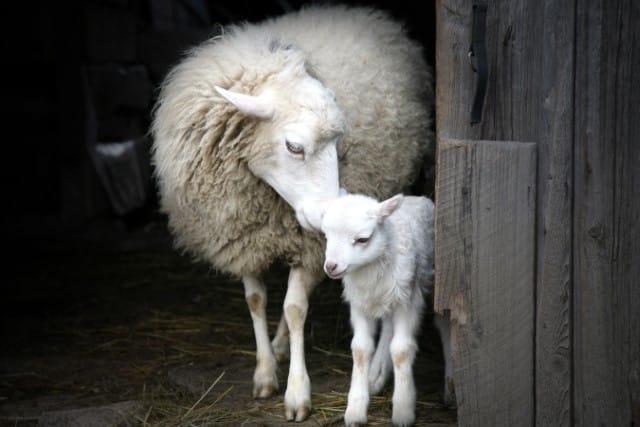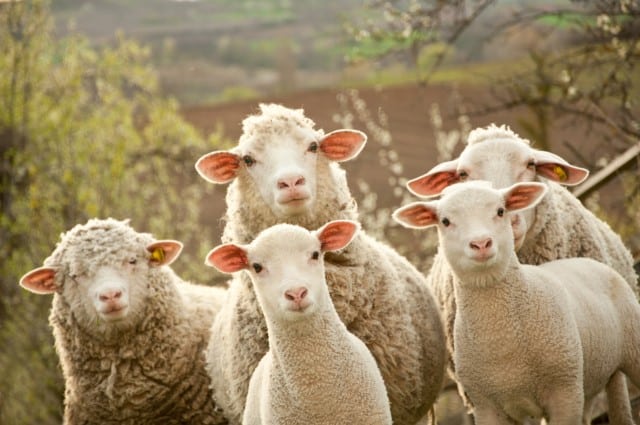As a sheep farmer, you must know how to wean lambs from their mother’s milk. It’s essential to put them onto grain and hay correctly and at the right time. Weaning lambs improperly leaves lambs at risk of different issues and problems developing later in its life.
In this article, I’ll go over how to tell when the best time to wean lambs is. I’ll also include some tips based on my 20+ years of experience raising sheep to do so properly.
When is the Best Time to Wean?
Weaning occurs when lambs no longer have access to milk from their mothers. Generally speaking, weaning also separates the lamb from its mother.

After weaning takes place, lambs may be given grain-based diets, forage, or mixed diets. Weanning stresses both lambs and ewes, and weaning properly lowers their stress as much as possible.
It may surprise you to know that there isn’t any one best age at which you should wean lambs. The age at which lambs are weaned varies within the sheep industry in the United States and other parts of the world.
The average time for weaning seems to be around four months, according to a NAHMS survey.
The most effective time at which you should wean your lambs depends on several different factors. These include pasture and feed supplies availability, facilities, and target markets. While there have been some lambs that have been weaned as young as 14 days, this isn’t recommended and it’s very unlikely to be successful.
My Preference
On our farm we typically weaned lambs at between 60 and 75 days of age. There was a range of ages because we preferred to wean lambs in groups – that just made managing it easier.
Since not every lamb was born on the same day, this 15-day range gave us the ability to wean lambs from multiple ewes at the same time.
At 60 days of age, most lambs have been eating grain and hay regularly in the creep area, and their digestive system had matured enough to continue to grow well on solid food.
How Lambs Wean Naturally?
Diametrically opposite to this is the practice of allowing for natural weaning, which involves keeping lambs with their mothers for as long as six months or longer.

Extremely young lambs cannot digest anything other than milk. Quite shortly after birth, however, they do start trying to nibble on dry feed. By the time the lamb reaches three weeks of age, the rumen it is developing means allows the animal to more efficiently convert solid feed to energy.
The milk production of a ewe is highest about three to four weeks after giving birth, then declines to approximately half that amount by 10 weeks. Ewes from breeds of sheep used on sheep dairy farms usually have a flatter lactation curve than ewes from more general breeds. They also produce a greater quantity of milk for a longer duration.
Early Weaning: Weaning Before 90 Days of Age
When a lamb is weaned early, it is weaned after 21 days of age and before 90 days. In intensive sheep operations, 60 days is the most common age for weaning lambs. In a dairy sheep operation, it’s common practice to wean the lambs when they are as young as 30 to 35 days old.

If a farmer is to do early weaning, they must be especially careful to keep the lambs properly hydrated and ensure that they are getting the right amounts of dry feed. This is usually a minimum of 0.5 pounds each day. Early weaning programs use creep feeding.
Pasture-reared lambs generally shouldn’t be weaned younger than 90 days old. Instead, they should usually be weaned at 120 days old.
In general, a lamb’s size at the time of weaning is more important than its age. The majority of lambs can usually be weaned by the time they are 60 days old or have reached 45 pounds in weight.
The age at which lambs can be weaned with little interruption to its growth rate will vary by breed.
For slower-growing and smaller breeds, lambs need not be quite as big for weaning as they would with other breeds. One rule of thumb that some farmers use is to wait until the lamb’s weight is three times what it weighed at birth.
What are the Advantages of Early Weaning?
There are several potential advantages to early weaning.
A weaned lamb is more efficient at transforming feed into lean tissue. Lambs convert feed into weight quicker than ewes convert their food into milk. Weaning lambs relatively early is usually more efficient for farms concerned with the cost of feed.
Be aware that early weaning can be very stressful for lambs and ewes. Also, the ewe may be more likely to develop mastitis, as they continue to produce milk even after the removal of the lambs.
The stress lambs experience puts them at greater disease risk without proper precautions.
Late Weaning: Weaning Lambs After 90 Days of Age
If farmers do not intervene, lambs will be naturally weaned from their mothers when they are about six months (180 days) old.
If you live in a region with a temperate climate, natural weaning will in most cases happen in the fall.

This is because that is the time at which ewes tend to go back to estrus.
Most lambs born in the spring are weaned a bit later than those born in the fall or winter. It’s quite common, in fact, to let lambs born in the spring stay with their mothers on pasture right up until when they go to market.
When it comes to late weaning, four months is the most typical age.
What Are the Advantages of Late Weaning?
Late weaning offers a number of different advantages. One of those is the fact that it is less stressful for the lambs and ewes.
Also, the ewe will be less likely to develop mastitis since her production of milk will have significantly declined by the time her lambs are taken away.
Finally, late weaning means that producers can keep lambs and ewes together in one management group. Depending upon how your farm is setup and how much housing and pasture you have available, this may simplify things for your farm considerably.
RELATED: How Many Sheep per Acre of Pasture is Ideal?
Why it’s Important to Reduce the Risk of Mastitis?
The prevention of mastitis is important because spoiled udders mean that the ewe will have reduced production value, or perhaps no production value at all, in the future.

One way to prevent this problem is to eliminate grain from the ewe’s diet about two weeks prior to weaning. Giving ewes hay for the last few days before weaning takes place will help to stop lactation naturally and ease the transition for them.
Something else that will help ewes shut down milk production is to keep them on a lower quality feed for between three and seven days after weaning occurs. Don’t let the ewe onto plentiful pasture right after weaning, as letting them graze there will increase milk production.
Make sure that you carefully examine ewes and check to see if they are developing mastitis. If you find that an ewe is developing mastitis, get the animal veterinary care.
The Environment for Weaning Your Lambs
Lambs are under even greater stress during weaning than ewes.
Stress is caused because the lambs are both separated from their dams and are also suddenly faced with the necessity of taking care of their own nutrition.

Also, a lamb doesn’t have a mature immune system. They are more likely to suffer from disease and are especially prone to internal parasites (such as coccidia and worms).
This is why you should give your lambs all their vaccinations before weaning takes place. Make sure that each lamb gets its first vaccination shot within 30 days of their birth. About three or four weeks later, there should be a booster vaccination.
The overeating disease vaccination is especially important for lambs.
Don’t Tag, Castrate, and Deworm The Same Day You Wean
Processes such as ear tagging, castration, and deworming should also be done well in advance of the process of weaning.
If you’re unable to do these things before weaning, you should wait for several weeks after weaning to do them. This will cut down on the stress lambs experience.
During the weaning process, make sure that the ewe is removed from the lamb. It should never be vice versa. Letting the lamb remain in the same place (somewhere familiar) will mean they experience less stress. Also, they won’t have any trouble finding their water, minerals, and feed.
Also, make sure to let siblings stay together during weaning.
A Tip About Fencing & Placement
One final note is that ewes should be separated from their lambs by more than a fence. If a lamb and its dam can see one another but not be able to get to one another that can add a layer of stress.
Make sure that fencing is secure, solid (if possible), and ideally the ewe is removed so that they are not in an abutting pen or paddock.
Lamb Weaning Doesn’t Have to be a Challenge
Weaning lambs properly is an important part of managing your flock of sheep. Plan it out ahead of time. This way you can make this as smooth as possible for your brood ewes and their lambs.
Like all other processes you do with your animals, it must be done humanely.
Understand that the first 24-48 hours in particular will be stressful for the lambs and their mothers. You should expect both groups to be quite vocal.

